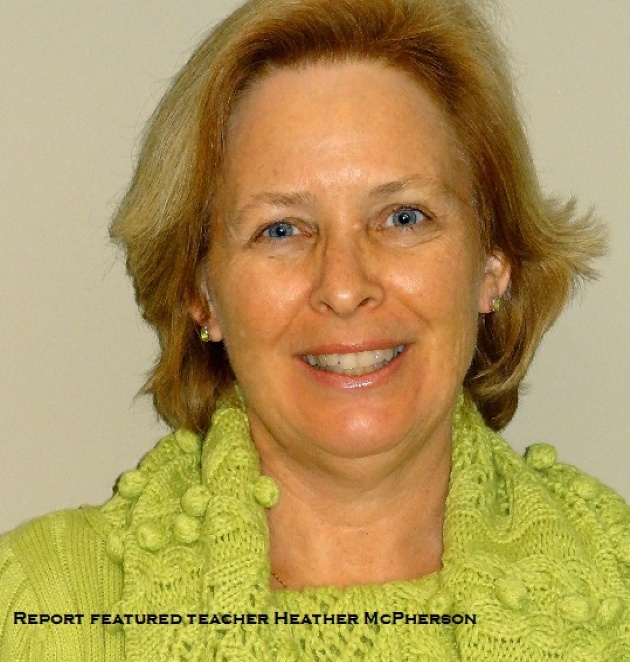Let us all take a moment to remember the very best teachers we had ‘along the path’ of life. What great and important memories spring forth!
Perhaps we owe a collective debt to our truly transformative teachers and perhaps this debt can best be paid in the actions we carry into the future.
The DEEN (Directors of English Education Network) recently published an important report called ‘Talking With Teachers’. The report was authored by Patricia Peter. The stated purpose of the report was to ‘examine the correlation between teacher practice and student successes. With the use of interview style data collection, the report gives us teachers’ wisdom and insights ‘straight from the horse’s mouth’. The teachers from Sir Wilfrid Laurier School Board that are featured in ‘Talking With Teachers’ include Claudie Lebel, Heather McPherson, Andrea Venditti, Maria Sakellaropoulous, and Hovig Halebi. These teachers were selected for a combination of strong student results on the June 2012 exams and a track record of effectively engaging students.
The number one finding amongst the forty five teachers interviewed for the report has to do with the teachers’ ability to connect with students. The teachers’ ability to form a powerful connection with students is not only a primary finding of this report; it is also supported by vast quantities of research. For example, John Hattie in his influential 2009 ‘Visible Learning’, indicates a very positive outcome level having to do with ‘positive teacher-student relationships’. In another famous study cited in ‘Talking with Teachers’, Ben Levin (2008) writes (in reference to keeping students in school) ‘is their feeling that someone in the school knows who they are and truly cares about their future.’
Another major factor described consistently by the selected teachers was ‘instructional and assessment expertise’. This factor has to do with what is commonly called ‘best practices’, which constitute the vast body of tried, tested, and researched teaching techniques, curriculum design, and learner considerations. When one begins to consider combined attributes, such as ‘connecting powerfully with students’ combined with ‘mastery of best practices’, the profile of a truly transformative teachers starts to emerge.
The ‘Talking with Teachers’ report creates a montage effect in its coverage of the 45 teachers, in that it provides an overarching narrative, while also availing to us several anecdotal diamonds. Of note, Heather McPherson explains the power of utilizing connectivity in the learning paradigm, with the use of Edmodo as the technological vehicle to connect students, teacher, and parents. Andrea Venditti has created her own Learning and Evaluation Situations, which are alluded to in the report, and also speaks to the vital component of routine in her practice.Hovig Halebi talks about ‘good mistakes’ and ‘bad mistakes’, and how to harness the ‘good mistakes’ in the deepening of understanding. Claudie Lebel describes her innovative curriculum design in which students become authors of historical fiction, and how that is connected with deep learning and the forming of cognitive connections in the process of historical thinking. Maria Sakellaropoulous talks about the great importance of the supporting mechanisms for CST students in her school from administration and Information Technology.
One of my favorite conversation starters of all time is, ‘who was your best teacher’? In my own experience, it is interesting that most of the people I have asked can almost instantly name one or two teachers as being their ‘best’. Sometimes it seems that the reason behind the selection has a mysterious quality. However, once deeply reflected upon, it is often the case that the remembered ‘best’ teacher had a great degree of ‘the human element’, including kindness, fairness, passion, enthusiasm, and well-timed humor; all held in combination with skill and ability. What I appreciate the most about the ‘Talking with Teachers’ report is that is gives us all an opportunity to reflect on the power of great teachers. It also allows us to pay attention to the techniques and factors involved in effective teaching. Great teachers influence the future in a vital and almost unimaginable way; the ‘Talking with Teachers’ brings us all into an acknowledgement of this reality.

 In The Latest Issue:Latest Issue:
In The Latest Issue:Latest Issue:
- Celebrating Community an...
- Celebrating the Unsung H...
- Understanding Newborn St...
Articles
Calendar
Virtual- ANNUAL TEACHER APPRECIATION CONTEST
- APPUI LAVAL
- ARTS & CULTURE
- CAMPS
- CAR GUIDE
- CCIL
- CENTENNIAL ACADEMY
- CHARITY FUNDRAISING
- CITYTV
- COSMODÔME
- COMMUNITY CONNECTIONS
- COVER STORY
- DINA DIMITRATOS
- ÉCOLE SUPÉRIEURE DE BALLET DU QUÉBEC
- EDITORIALS
- ÉDUCALOI
- EDUCATION
- EMPLOYMENT & ENTREPRENEURSHIP
- FÊTE DE LA FAMILLE
- FÊTE DU QUARTIER SAINT-BRUNO
- FAMILIES
- FESTIVAL LAVAL LAUGHS
- FÊTE DE QUARTIER VAL-DES-BRISES
- FINANCES
- GLI CUMBARE
- GROUPE RENO-EXPERT
- HEALTH & WELL-BEING
- 30 MINUTE HIT
- ANXIETY
- CHILDREN`S HEALTH & WELLNESS
- CLOSE AID
- DENTAL WELLNESS
- EXTREME EVOLUTION SPORTS CENTRE
- FONDATION CITÉ DE LA SANTÉ
- GENERAL
- HEARING HEALTH
- MESSAGES FROM THE HEALTH AGENCY OF CANADA
- MENTAL HEALTH
- SEXUALITY
- SOCIAL INTEGRATION
- SPECIAL NEEDS
- TEENS
- THE NUTRITION CORNER
- THE NUTRITION CORNER - RECIPES
- VACATION DESTINATION
- WOMEN'S FITNESS
- WOMEN'S HEALTH
- HILTON MONTREAL/LAVAL
- HOME & GARDEN
- INTERNATIONAL WOMEN'S DAY
- JAGUAR LAVAL
- LAVAL À VÉLO
- LAVAL FAMILIES TV SHOW
- LAVAL FAMILIES MAGAZINE CARES
- LAVAL URBAN IN NATURE
- LE PARCOURS DES HÉROS
- LES PETITS GOURMETS DANS MA COUR
- LEON'S FURNITURE
- LEONARDO DA VINCI CENTRE
- LFM PREMIERES
- LIFE BALANCE
- M.P. PROFILE
- MISS EDGAR'S AND MISS CRAMP'S SCHOOL
- MISSING CHILDREN'S NETWORK
- NETFOLIE
- NORTH STAR ACADEMY LAVAL
- OUTFRONT MEDIA
- PASSION SOCCER
- PARC DE LA RIVIÈRE-DES-MILLE-ÎLES
- PÂTISSERIE ST-MARTIN
- PIZZERIA LÌOLÀ
- PLACE BELL
- PORTRAITS OF YOUR MNA'S
- ROCKET DE LAVAL
- SACRED HEART SCHOOL
- SCOTIA BANK
- SHERATON LAVAL HOTEL
- SOCIÉTÉ ALZHEIMER LAVAL
- STATION 55
- STL
- SUBARU DE LAVAL
- TECHNOLOGY
- TEDXLAVAL
- TODAY`S LAURENTIANS AND LANAUDIÈRE
- TODAY`S LAVAL
- WARNER MUSIC
- THIS ISSUE
- MOST RECENT
Magazine
The DEEN 'Talking with Teachers Report'
Articles ~e 105,7 Rythme FM 4 chemins Annual Teacher Appreciation Contest Appui Laval Arts & Culture Ballet Eddy Toussaint Camps THIS ISSUE MORE...
CONTESTS Enter our contests
CONTESTS Enter our contests
CALENDAR
Events & Activities
COMMUNITY Posts Events
PUBLICATIONS Our Magazine Family Resource Directory
LFM BUSINESS NETWORK Learn more
COUPONS Click to save!
COMMUNITY Posts Events
PUBLICATIONS Our Magazine Family Resource Directory
LFM BUSINESS NETWORK Learn more
COUPONS Click to save!
SUBSCRIPTIONS
Subscribe to the magazine
Un-Subscribe
E-NEWSLETTER Subscribe to our E-newsletter Un-Subscribe
WRITE FOR US Guidelines & Submissions
POLLS Vote today!
E-NEWSLETTER Subscribe to our E-newsletter Un-Subscribe
WRITE FOR US Guidelines & Submissions
POLLS Vote today!
ADVERTISERS
How to & Media guide
Pay your LFM invoice
SUGGESTIONS Reader's Survey Suggest a Listing
LFM About Us Our Mission Giving Back Contact Us
SUGGESTIONS Reader's Survey Suggest a Listing
LFM About Us Our Mission Giving Back Contact Us
 PICK-UP LOCATIONS
Get a copy of LFM!
PICK-UP LOCATIONS
Get a copy of LFM!
TERMS & CONDITIONS Privacy | Terms
ISSN (ONLINE) 2291-1677
ISSN (PRINT) 2291-1677
Website by ZENxDESIGN



 BY:
BY: 


Tweet
Share